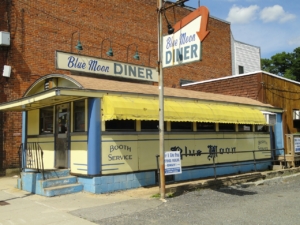By Eddie Pipkin
This week, a couple of restaurant tales to emphasize ministry mistakes to be avoided..
First, my friend Jeff’s attempt to meet me at a local burger bar. My friend (Jeff, as noted) had an appointment in my neighborhood, and he texted to see if I wanted to meet him to try out a local burger joint  he had noticed a couple of doors down from his eye doctor destination. I knew this place, a quaint little cube of a building with some colorful chairs out front, specializing in specialty burgers like the mac-n-cheese and the Elvis (peanut butter and bacon), shakes, and cheese curds. I had been there twice, once when the AC was out (which I decided had unfairly tarnished the experience) and once when they got everything right and I had a good time. I couldn’t meet friend Jeff on the day of his appointment, so he checked it out on his own, keeping in mind my caution that I found the place to be hit-or-miss. He got the ‘miss’ experience.
he had noticed a couple of doors down from his eye doctor destination. I knew this place, a quaint little cube of a building with some colorful chairs out front, specializing in specialty burgers like the mac-n-cheese and the Elvis (peanut butter and bacon), shakes, and cheese curds. I had been there twice, once when the AC was out (which I decided had unfairly tarnished the experience) and once when they got everything right and I had a good time. I couldn’t meet friend Jeff on the day of his appointment, so he checked it out on his own, keeping in mind my caution that I found the place to be hit-or-miss. He got the ‘miss’ experience.
When he came in the door, no one greeted him, and no clear instructions presented themselves, so he took a seat in a booth. A few other people were eating and chatting, but no server appeared for several minutes. Finally, a new customer entered and walked straight up to the counter across the room. An employee emerged from the kitchen behind the counter and took the customer’s order. “Oh! It’s a counter service place!”: My friend got it—he’s sharp when presented with sufficient data points—but by then he felt awkward and embarrassed that he’d been sitting there like a no-nothing, and even as he placed his order and returned to his seat to await his food, he was soured on the whole experience. The burger and sides came, and he judged them “all right,” but not nearly so much as to outweigh his negative beginning. “I won’t be stopping in there again,” he concluded. The food was okay. The décor was cute, but not distinctive enough to be special. The service was, in his eyes, completely lacking. As a customer, he was one-and-done.
Of course, having been there before, I knew the place was counter service. Hearing about his experience, I was fascinated with wondering if he might have had a completely different take on things if I had been with him to serve as guide (and potential cheerleader) for this local joint. Still, customer service is paramount. [As an aside, I once had another friend who opened a restaurant off the beaten path with really good food, but he used his teenaged daughter and her teenaged friends as the hospitality and servers, and they were terrible—slow, inattentive, disinterested. I used to say to my friend (George), “Man, this food is great, but it does not matter how good the food is. If the service continues to be this bad, people won’t come. You can get by with okay food if you present it with stellar service, but people won’t put up with bad service, no matter how good the food is.” He went under in six months.]
For churches, we can get carried away making this customer service comparison, but time and again we experience reminders of the way the parallels ring true. I recently visited a church that my wife and daughter had previously attended without me. They really liked the worship service, the music, and the pastor, but as we parked the car and crossed towards the sanctuary, my wife said, “I’m just going to warn you, when we go into the vestibule, it’s going to be really awkward.” (She knows I am as big a fan of awkward as friend Jeff.) Sure enough, it was oddly, uncomfortably, cringe-inducing awkward. They had the doors to the sanctuary closed like you needed a secret code to pass—I think they were rehearsing something in there. They had greeters with bulletins in their hands, but they stood in their positions like wax figures or animatronics, no conversation, no engagement. There was (my spies knew) a fellowship time of food and conversation in an adjacent hall, but in the vestibule, there was no signage or other indication to go have a donut and chat. It was all standing around and studying the carpet and paneling; so awkward for me—and I am not making this up—that I faked a bathroom trip down the hall to the right (that’s where you don’t really have to go; you just fake having to go to have something to do).
Avoiding this kind of scenario was the impetus for the whole movement from greeters and ushers to the concept of Hospitality Teams. But Hospitality Teams are only as effective as their leadership, training, and attention to important details like chatting up folks who are standing awkwardly in the vestibule or making the waiting-for-worship-to-start options clear and friendly for new souls wandering in from the street. What are you doing to actively look at the “entering the church” experience through the eyes of those who’ve done you the honor of coming to check out your community?
On a completely different note, illustrative restaurant tale number two: the demise of the long-time diner.
Some additional friends and I get together on Tuesday mornings for a book read / Bible study group, which includes breakfast, and we have met for years at a bustling downtown diner, cheap, friendly, and featuring a menu loaded with country favorites (which for me always includes a well-made bowl of grits and some biscuits which remind me of grandma). This place was routinely packed, breakfast through lunch. It was a mainstay of local popularity. Alas! It was sold (the old owners ready for retirement), and the new owners, brimming with excitement and a passionate vision for a revised menu and a whole new approach . . . knew nothing about running a successful restaurant. They changed everything from overhauling the menu to completely replacing the staff. There was no continuity from the old to the new, and the new things they attempted, they did not do well. Our first week under the new regime, our server showed up to work 20 minutes late, and we sat there without so much as a cup of coffee. When it was time to order, none of our breakfast favorites were part of the new concept, and the new items we were able to choose were bland and small-portioned.
It was a disaster. After a couple of weeks with no discernible improvement, we moved to the barbecue place down the block (which, as a counter-example of customer service, agreed to open an hour early just to host our group). Within two months, the long-time successful diner had gone bust. It lived on only as a powerful example of the danger of change for change’s sake. In ministry circles, when new leadership sweeps into town with new visions and an aversion to “all that has gone before,” changes can come fast and furiously, without consultation, without buy-in, without explanation, and without thoughtful anticipation of what has kept people connected as a community. People are not always averse to change. They will often welcome some new menu items—as for me, I would gladly have supplemented my traditional bowl of grits with a selection of hipster avocado toast—but they need a pace of change that gives them time to process what is new, they need help understanding the new vision, they need conversation and buy-in, and they definitely need for the things are new to be done with excellence.
What has been your own ministry experience with either of the restaurant-based scenarios presented above? Have you seen change handled poorly and with inadequate forethought? Have you experienced awkwardness in navigating a new place? Have you attempted to shepherd either of these processes in a positive direction, only to be thwarted? Do you have stories of success? Do you have your own restaurant parallels to share?
Share them here for all of us, or else meet me for breakfast at the local diner!







Leave A Comment